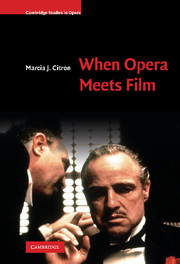Book contents
- Frontmatter
- Contents
- List of figures
- List of tables
- List of music examples
- Acknowledgments
- Introduction
- Part I Style
- Part II Subjectivity
- Part III Desire
- 5 “An honest contrivance”: opera and desire in Moonstruck
- 6 The sound of desire: Così's “Soave sia il vento” in Sunday, Bloody Sunday and Closer
- Epilogue
- Notes
- Bibliography
- Filmography and videography
- Index
6 - The sound of desire: Così's “Soave sia il vento” in Sunday, Bloody Sunday and Closer
from Part III - Desire
Published online by Cambridge University Press: 04 August 2010
- Frontmatter
- Contents
- List of figures
- List of tables
- List of music examples
- Acknowledgments
- Introduction
- Part I Style
- Part II Subjectivity
- Part III Desire
- 5 “An honest contrivance”: opera and desire in Moonstruck
- 6 The sound of desire: Così's “Soave sia il vento” in Sunday, Bloody Sunday and Closer
- Epilogue
- Notes
- Bibliography
- Filmography and videography
- Index
Summary
May the wind be gentle, may the sea be calm, and may the elements respond kindly to our desires.
“Soave sia il vento,” in Così fan tutteMozart's Così fan tutte is one of the most sensuous operas in the repertoire. With ravishing sonorities that linger in the imagination long after it is over, Così holds a special place in the operatic canon and inspires awe-struck admiration in many opera lovers. The Così sound comes from a surfeit of thirds and sixths, which often function dramatically, and magical orchestration that assigns the winds a prominent role, especially the clarinet. Not surprisingly, desire looms large in the heightened aesthetic realm, and Mozart's opera centers on this rarefied quality. Così pays particular attention to the desire for ideal love, which drives the plot, and the consequences for the characters when that desire is denied. While the opera features many numbers that touch on desire, the trio “Soave sia il vento” embodies this quality more than any other, and it serves as a signature piece for the work.
We explore two major films that link “Soave” with desire: John Schlesinger's Sunday, Bloody Sunday (1971) and Mike Nichols's Closer (2004). Sunday, which appeared shortly after Schlesinger's Oscar-winning film Midnight Cowboy, captures Britain's social confusion after the heady Mod culture of the 1960s. Closer, with a mixed Anglo-American cast, replays themes of sexual competition and psychic brutality from early Nichols movies, especially Who's Afraid of Virginia Woolf? (1966) and Carnal Knowledge (1971).
- Type
- Chapter
- Information
- When Opera Meets Film , pp. 212 - 245Publisher: Cambridge University PressPrint publication year: 2010



